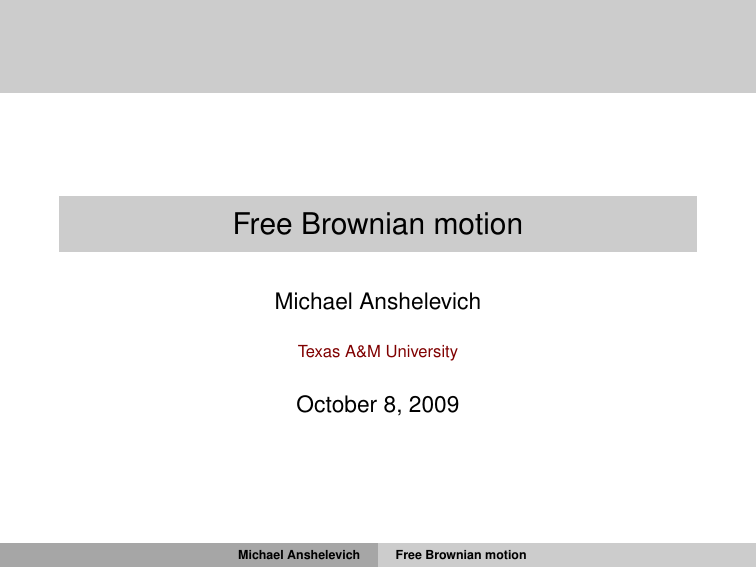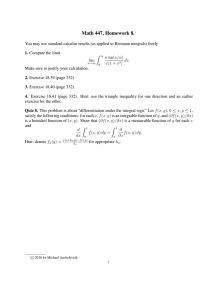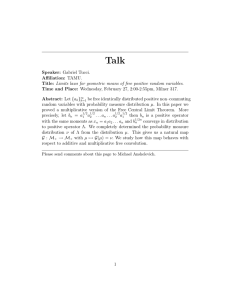Free Brownian motion Michael Anshelevich October 8, 2009 Texas A&M University
advertisement

Free Brownian motion
Michael Anshelevich
Texas A&M University
October 8, 2009
Michael Anshelevich
Free Brownian motion
Definition I: Combinatorics.
Catalan numbers
2k
1
:
ck =
k+1 k
1, 1, 2, 5, 14, . . .
Count many things (Stanley Exercise 6.19(a-nnn) +109).
Count lattice paths:
,
,
,
,
,
,
How many with k steps?
m2k+1 = 0.
m2k = ck = Catalan number.
Michael Anshelevich
Free Brownian motion
,
combinatorial
Numbers → structures → measures.
Interpret {mk } as moments. More precisely, mk tk/2 .
Want a measure µt on R such that
Z ∞
k/2
mk t
=
xk dµt (x)
−∞
1 √
Combinatorics ⇒ µt =
4t − x2 dx = semicircle laws.
2πt
Michael Anshelevich
Free Brownian motion
Definition II: Operators.
a+ = right shift.
1
2
3
4
6
5
a− = left shift.
a− a+ = Id,
a+ a− 6= Id
Matrices
0
+
a ∼
0
0
0
..
.
.
1 0 0 0 ..
.. ,
.
0 1 0 0
..
.
0 0 1 0
.. .. .. .. ..
. . . . .
Michael Anshelevich
0
−
a ∼
1
0
0
..
.
..
.
..
.
0 0 0 1
..
.
0 0 0 0
.. .. .. .. ..
. . . . .
0
0
Free Brownian motion
1
0
Operators.
0
X ∼ a+ + a− ∼
1
0
0
..
.
..
.
.. .
.
0 1 0 1
..
.
0 0 1 0
.. .. .. .. ..
. . . . .
1
0
1
0
Symmetric matrix; in fact a self-adjoint operator.
Tri-diagonal (orthogonal polynomials).
Michael Anshelevich
Free Brownian motion
Operators.
Can realize (more complicated) operators
+
a (t), a− (t) : t ≥ 0
with
a− (s)a+ (t) = min(s, t) Id
and
X(t) = a+ (t) + a− (t).
Each X(t) = self-adjoint operator.
Proposition.
D
E
X(t)k e1 , e1 = mk tk/2 ,
so X(t) ∼ µt , X(t) has distribution µt .
Michael Anshelevich
Free Brownian motion
Operators.
Why?
X(t)4 e1 , e1 = (a+ + a− )(a+ + a− )(a+ + a− )(a+ + a− )e1 , e1
Using a− (t)e1 = 0 and a− (t)a+ (t) = t Id, only left with
− − ++
=
t2
,
− + −+
=
t2
.
Michael Anshelevich
Free Brownian motion
Free Brownian motion.
{Xt } not just individual operators with these distributions.
{X(t) : t ≥ 0} form a process.
{X(t)} = free Brownian motion.
Each X(t) ∼ µt . Increments
X(t1 ) − X(t0 ),
X(t2 ) − X(t1 ), . . . ,
X(tk ) − X(tk−1 )
freely independent.
Xt0 · · · · · · · · · · · · Xt1 · · · · · · Xt2 · · · · · · · · · · · · · · · · · · Xt3 .
Have other processes, other types of increments.
Michael Anshelevich
Free Brownian motion
Definition III: Random matrices.
Mn (t) = n × n symmetric random matrix,
√1
Mn (t) =
√1 Bt √1 Bt
B
n 2t
n
n
1
√ Bt √1 B2t √1 Bt
n
n
n
√1 Bt √1 Bt √1 B2t
n
n
n
..
.
..
.
..
.
...
...
...
..
.
.
Bt = (usual) Brownian motion.
1
Tr(Mn (t)k ) = (random) number.
n
Michael Anshelevich
Free Brownian motion
Random matrices.
Proposition.
As the size of the matrix n → ∞,
1 Tr Mn (t1 )Mn (t2 ) . . . Mn (tk ) −→ hX(t1 )X(t2 ) . . . X(tk )e1 , e1 i.
n
In particular, n1 Tr Mn (t)k → mn tk/2 .
{Mn (t) : t ≥ 0} = asymptotically free Brownian motion.
Michael Anshelevich
Free Brownian motion
Random matrices.
Proof I. (Wigner 1958, L. Arnold 1967)
∞
X
1
1 Tr Mn (t1 )Mn (t2 ) . . . Mn (tn ) =
paths.
k/2
n
n
k=0
Proof II. (Trotter 1984)
√1 N
n
√1 χn
n
0
tridiagonalization √1 χn √1 N √1 χn
n
n
n
Mn
−→
0 √1 χ √1 N
n n
n
..
..
..
.
.
.
Michael Anshelevich
..
.
0 1 0
..
. n→∞
1 0 1
−→
..
0 1 0
.
.. .. ..
. . .
..
.
Free Brownian motion
..
.
..
.
..
.
.. ..
. .
.
Definition IV: Permutations.
S = infinite symmetric group.
C[S] = its group algebra
= formal linear combinations of permutations.
ϕ[w] = constant term
= coefficient of the identity permutation in w.
(0a) transposition.
Denote
[nt]
1 X
L(n, t) = √
(0i) ∈ C[S].
n
i=1
Michael Anshelevich
Free Brownian motion
Permutations.
Proposition.
As n → ∞,
h
i
ϕ L(n, t1 )L(n, t2 ) . . . L(n, tk ) −→ hX(t1 )X(t2 ) . . . X(tk )e1 , e1 i.
In particular
i
h
ϕ L(n, t)k → mk tk/2 .
Michael Anshelevich
Free Brownian motion
Permutations.
Why?
[nt]
1 X
L(n, t) = √
(0i)
n
no e
i=1
so ϕ [L(n, t)] = 0.
[nt]
1 X
(0i1 )(0i2 )
n
i1 ,i2 =1
X
1
(0i1 i2 ) + [nt]e ≈ . . . + te
=
n
L(n, t)2 =
i1 6=i2
so ϕ L(n, t)2 = t. Etc.
Michael Anshelevich
Free Brownian motion
Free Probability Theory.
Combinatorics.
Operator representations.
Random matrix theory.
Group algebras (symmetric and free).
Other approaches:
Orthogonal polynomials.
Asymptotic representation theory (Young diagrams).
Operator algebras applications.
Complex analysis techniques.
Michael Anshelevich
Free Brownian motion
Free Probability Theory.
Upshot:
Do not need to know all of this.
Can enter the field by knowing one of these.
Helps to learn the rest as time goes on.
Michael Anshelevich
Free Brownian motion








